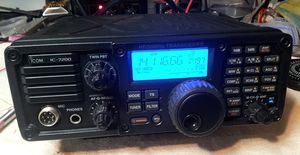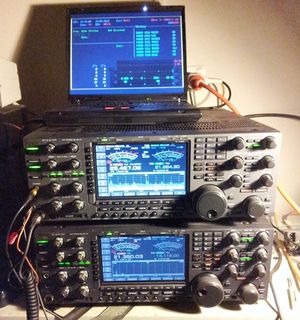Amateur Radio
A retired military officer in North Carolina makes friends over the radio with an amateur radio operator (known the world over as “hams”) in Lithuania. An Ohio teenager uses her computer to upload a chess move to an orbiting space satellite, where it’s retrieved by a fellow chess enthusiast in Japan. In California, volunteers save lives as part of their involvement in an emergency communications network. And at the scene of a traffic accident on a Chicago freeway, a ham calls for help by using a pocket-sized hand-held radio.
This unique mix of fun, public service, and convenience is the distinguishing characteristic of amateur radio. Some hams are attracted to the idea of communicating across the country, around the globe, and even with astronauts on space missions. Others enjoy building and experimenting with electronics. Although hams get involved in the hobby for many reasons, all have a basic knowledge of radio technology, regulations, and operating principles and must pass an examination for a license to operate on radio frequencies known as the amateur bands.
Amateur radio is as old as radio itself. Not long after Italian experimenter Guglielmo Marconi transmitted the Morse Code letter “s” from Wales to Newfoundland, Canada in 1901, amateur experimenters throughout the world were trying out the capabilities of the first “spark gap” transmitters. In 1912 Congress passed the first laws regulating radio transmissions in the United States. By 1914 amateur experimenters were communicating nationwide, and setting up a system to relay messages from coast to coast. In 1927 Congress created the precursor agency to the Federal Communications Commission (FCC) and specific frequencies were assigned for various uses, including ham bands.
If you were to look at the dial on an old AM radio you’d see frequencies marked from 535 to 1605 kilohertz (kHz). Imagine that band extended out many thousands of kilohertz, and you’ll have some idea of how much additional radio spectrum is available for amateur, government, and commercial radio bands. It is here you’ll find aircraft, ship, fire and police communication, as well as the so-called “shortwave” stations, which are worldwide commercial and government broadcast stations from the U.S and overseas. Amateurs are allocated nine basic “bands” (i.e,. groups of frequencies) in the High Frequency (HF) range between 1800 and 29,700 kHz, and another seven bands in the Very High Frequency (VHF) and Ultra High Frequency (UHF) ranges. There are nine more segments in the Super High Frequency (SHF) and Extremely High Frequency (EHF) microwave bands. Finally, hams can use any frequency above 300 gigahertz (GHz)!
Given the right frequency and propagation conditions, amateur radio conversations can take place across town and around the world. Those with a competitive streak enjoy amateur radio contests, where the object is to see how many hams they can contact in a certain time, often a weekend. Some like the convenience of a technology that gives them portable communication. Others use it to open the door to new friendships over the air or through participation in one of thousands of amateur radio clubs throughout the world.
Governing Bodies
Amateur radio is largely governed globally by the International Amateur Radio Union (IARU), a representative body in the ITU. The IARU comprises representatives from each of the national bodies, eg ARRL in the US, WIA in Australia, PZK in Poland, SARTS in Singapore, MARTS in Malaysia, JARL in Japan, NZART in New Zealand. [and more].
Individual PTT's directly regulate licensing in each Country, examples are FCC (in the USA), ACMA (Australia), Post Office (Solomon Islands), [and more ].
Licensing in the United States began with the Radio Act of 1912.
Spinoffs
There have been some amazing business spinoffs generated by amateur radio enthusiasts, the vacuum tube manfacturer Eimac, ICOM, Yaesu, Codan and probably others. See the Hy-gain TH7DX antenna story.
Additionally there have been some remarkable explorations into communications, eg, EME Communications, super low bandwidth communications (approx 6Hz channel bandwidth) , eg WSJT, PSK31 (approx 50hz channel bandwidth), etc.
Amateur Radio Callsigns
INDIA - http://en.wikipedia.org/wiki/Amateur_radio_callsigns_of_India
USA - http://earlyradiohistory.us/recap.htm
EMR Safety Calculator / RF Safety Calculator
Amateur Radio operators are required to perform EMR Safety Calculations, that control the safe exposure distances to controlled and uncontrolled radio frequency (or EMF) environments. These safety calculations and resultant compliance requirements have largely become mandatory by most regulators. The operator can be asked to produce these calculations when requested by the regulator. The FCC introduced it in 1997, New Zealand in 2000 and Australia in 2002.
- The following spreadsheet replicates ALL the regulators tables / formulas and complex safety distance lookup tables found in both the FCC, New Zealand and Australian requirements. It also covers power levels in excess of that legally permitted, as well as the safety calculation for 60m (5MHz) frequency band (which is not part of any guideline currently). Please read the notes and exclusions in the spreadsheet notes page.
RF EMR Safety Exposure Calculator (xls)
This spreadsheet calculator addresses the Amateur Radio Operator RF Safety compliance obligations to the following guidelines/standards:
- Australia - Human Exposure to EMR: Assessment of Amateur Radio Stations for Compliance with ACA Requirements, May 2005, version 2.0
- USA - FCC Sup B to OET B65 Ed97-01
- New Zealand - NZS2772-1999
Further reading:
It Started with Ham Radio, a First Hand History by Pete Lefferson
1907 Wireless Licence application form (pdf)
Amateur radio IC-7800's photo
This site is made possible by donations. If you find these articles valuable, please consider supporting the IEEE History Center’s work by making a donation to IEEE Foundation - History Center Fund. There is a box marked “Designations” with an arrow which allows you to assign your gift to the History Center.



